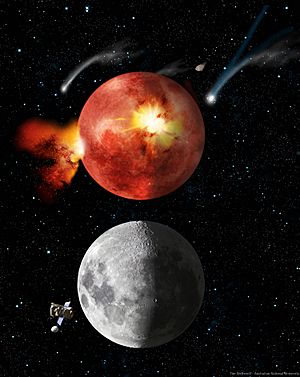Late Heavy Bombardment facts for kids
The Late Heavy Bombardment (LHB) or lunar cataclysm was a time long, long ago, about 4.1 to 3.8 billion years back. During this period, a huge number of space rocks crashed into the Moon. This caused many big holes called impact craters. Scientists believe the same thing happened on Earth, Mercury, Venus, and Mars too. Imagine our early Earth being hit by countless asteroids!
Scientists found evidence for this event by studying moon rocks. They used a method called radiometric dating to find out how old these rocks are. Most of the rocks that melted from impacts formed during this time. Many ideas try to explain why so many asteroids or comets crashed into the inner Solar System. But scientists don't all agree yet. One popular idea is that the giant planets like Jupiter and Saturn moved their orbits around this time. This movement might have pushed objects from the asteroid belt or Kuiper belt towards the inner planets, causing the massive bombardment.
Some scientists think that the way we collected the moon rock samples might make it look like all the impacts happened at the same time, even if they didn't.
Contents
What Caused the Late Heavy Bombardment?
Scientists are still working to understand exactly what caused the Late Heavy Bombardment. One of the main ideas is called the Nice model. This model suggests that the giant planets in our solar system, like Jupiter, Saturn, Uranus, and Neptune, changed their orbits.
The Nice Model Explained
About 4.5 billion years ago, when our solar system was new, the giant planets were closer together. They were also closer to a big ring of icy objects, like a second asteroid belt, beyond Neptune. Over time, these planets slowly moved. Jupiter moved a bit closer to the Sun, and Saturn, Uranus, and Neptune moved farther away.
Planetary Migration and Asteroid Scattering
As the giant planets moved, their strong gravity pulled on the icy objects and asteroids. This pulling and pushing changed the paths of many of these space rocks. It was like a giant game of pinball in space! Many asteroids and comets were thrown out of their usual orbits. Some of them were sent flying inwards, right towards the inner planets like Earth and the Moon. This sudden increase in space rocks hitting the inner solar system is what we call the Late Heavy Bombardment.
Evidence from the Moon
The Moon is a great place to study the Late Heavy Bombardment. This is because the Moon has no wind, water, or volcanoes to erase old craters. So, the craters from billions of years ago are still there for us to see.
Moon Rocks and Dating
Astronauts from the Apollo missions brought back many rock samples from the Moon. When scientists studied these rocks, they found something interesting. Many of the rocks that were melted by impacts were all about the same age. They were formed between 4.1 and 3.8 billion years ago. This strong evidence suggests a period when impacts were much more common than they are today.
Craters on Other Planets
While we have moon rocks, we can also see the signs of this bombardment on other planets. Mercury, for example, is covered in craters, much like the Moon. Mars also has many ancient craters. Even on Earth, though most old craters have been worn away by weather and geology, scientists find evidence of very old impacts.
Related pages
Images for kids
-
Simulation showing outer planets and planetesimal belt: (a) Early configuration, before Jupiter (green) and Saturn (orange) reach 2:1 resonance; (b) Scattering of planetesimals into the inner Solar System after the orbital shift of Neptune (dark blue) and Uranus (light blue); (c) After ejection of planetesimals by planets.
See also
 In Spanish: Bombardeo intenso tardío para niños
In Spanish: Bombardeo intenso tardío para niños


